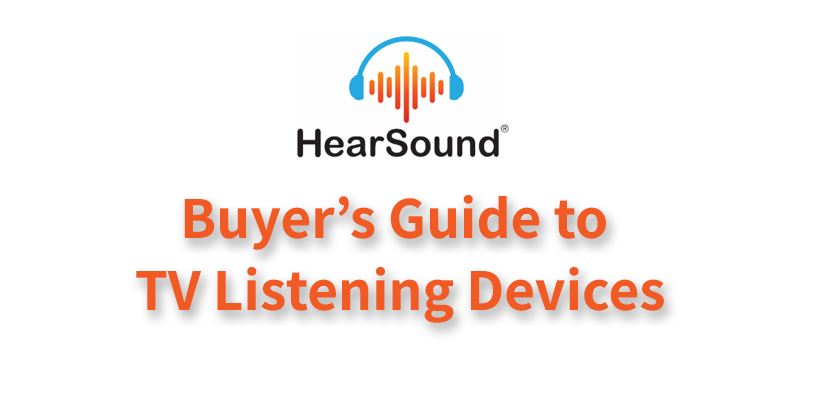Television should be one of the easiest ways to relax at home. You sit down, turn it on, and escape into a story. But for many people, TV sound is no longer enjoyable. Dialogue is muffled, background effects are too loud, and turning the volume up only sparks complaints from the rest of the household.
That’s where TV hearing devices come in. These systems bring dialogue back to the front, let you personalize volume, and restore the joy of watching together. The challenge is knowing which device to choose. There are different designs, features, and price points—and not all of them are worth it.
This Buyer’s Guide will walk you through the most important factors to consider, highlight how HearSound models compare, and explain why customer service and value for price are the two things that matter most when you’re making your decision.
Step One: Understand Your Needs
Before comparing brands and models, start by asking yourself a few simple questions:
-
Do you mainly struggle with dialogue clarity, or is it overall loudness?
-
Do you watch alone, or do you share TV time with others who have different hearing needs?
-
Do you want something lightweight and simple, or are you comfortable with over-ear headphones for richer sound?
-
Would you rather have a headset—or a small speaker that sits close by?
-
How comfortable are you with charging cables, bases, and setup steps?
Your answers will point you toward the type of device that fits best.
Step Two: Key Features to Compare
Every TV hearing device will claim to make dialogue clearer, but the differences are in the details. Here are the main factors to look at:
-
Sound clarity – Does it sharpen dialogue and reduce background effects?
-
Comfort and style – Will you actually want to wear it for a full movie?
-
Charging system – Cord vs. charging base—small details that make daily use easier.
-
Wireless range and reliability – Can you move around the room without dropouts?
-
Ease of setup – Simple plug-in vs. complicated instructions.
-
Multi-user options – Can more than one person listen at their own volume?
-
Warranty and support – Who helps you when things don’t work as expected?
The last point—support—is where many products fail. We’ll come back to this, because it’s critical.
Step Three: The HearSound Lineup
Here’s how the current HearSound models compare, and who each one is best for:
| Model | Description | Best for: | |
 |
Gold | Wireless TV headset system with USB cord charging. |
Those who want a simple, reliable starting model at a fair price. |
 |
Platinum |
Wireless TV headset system with a charging base. Same as Gold, but you recharge by docking the headset instead of plugging in a cable. |
Anyone who wants the convenience of a drop-in cradle- easier for seniors or anyone who dislikes cords. |
 |
Theatre |
Premium over-ear wireless headphones with higher fidelity and richer sound. |
Viewers who want the most immersive listening experience and don’t mind a full headphone style. |
 |
SoundBall |
Round portable speaker you place near you instead of wearing a headset. |
People who don’t like headsets but still want personalized, close-up sound without blasting the room. |
 |
Extra Headset |
Add-on unit that pairs with an existing system. |
Couples or households where two people want independent volume control. |
Step Four: What Really Sets HearSound Apart
Here’s the truth: there are dozens of TV hearing devices out there. Some are cheaper, some are fancier. But the biggest differentiators aren’t hidden specs—they’re service and value.
1. Friendly, US-Based Customer Service
-
You’re never left hunting through a manual on your own.
-
Support is based in the US, with real people who understand the products and the people who need them.
-
Setup videos, guides, and 24/7 help mean you’ll never be stuck for long.
2. Quality for the Price
-
Every HearSound device is built to deliver clarity and reliability without bloated pricing.
-
Gold and Platinum compete with products twice the cost, but include all the necessary cables and a transmitter in the box.
-
Theatre brings premium fidelity without “audiophile” sticker shock.
-
SoundBall gives you a completely different form factor at an affordable entry point.
Together, support and fair pricing make HearSound a safer investment. You’re not just buying hardware—you’re buying the confidence that it will work in your home, and that someone will help if it doesn’t.
Step Five: Pitfalls to Avoid
When comparing, watch out for these common mistakes:
-
Buying on volume, not clarity. Louder doesn’t mean clearer.
-
Overlooking comfort. A device you hate wearing will sit unused.
-
Forgetting about charging. If plugging in cables daily is a hassle, consider Platinum’s charging base.
-
Ignoring support. A cheap knock-off may look tempting until you realize there’s no one to call when it doesn’t connect to your TV.
Step Six: Quick Checklist
Before you buy, confirm:
-
Works with your TV’s outputs (optical or 3.5mm).
-
Comfortable for your style of watching.
-
Charging system you like (USB vs. cradle).
-
Option for an extra headset if you’ll share.
-
Backed by US-based support and a 30-day return guarantee.
The Bottom Line
The right TV hearing device doesn’t just make sound louder—it makes it clearer, easier, and more enjoyable for everyone in the room.
-
Start with Gold if you want a simple, affordable solution.
-
Step up to Platinum if you want the convenience of a charging base.
-
Choose Theatre for the richest sound.
-
Pick SoundBall if you don’t want to wear a headset at all.
-
Add an Extra Headset if two people will use it.
But whatever you choose, remember: the two things that matter most are support and value. With HearSound, you’re backed by friendly US-based help, clear guides, and fair pricing that delivers more than you expect. That’s what makes the difference between frustration and enjoyment—between watching TV and truly hearing it again.


